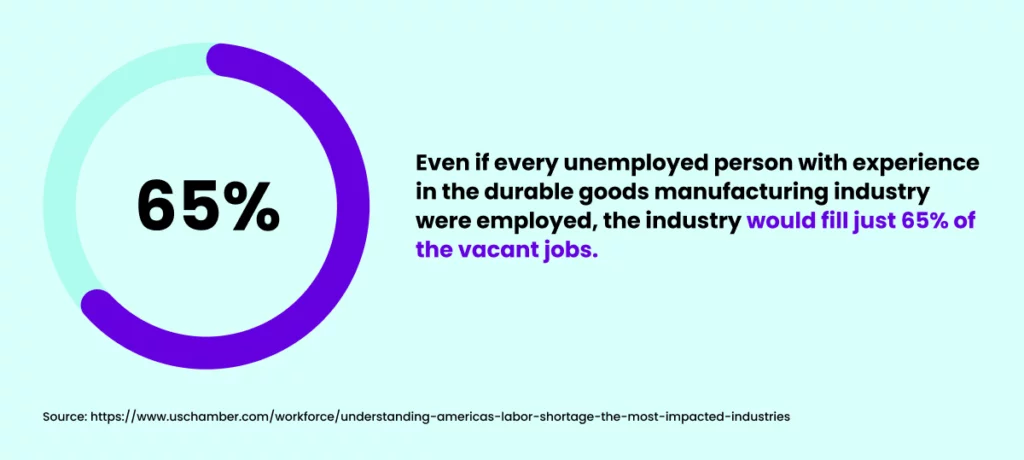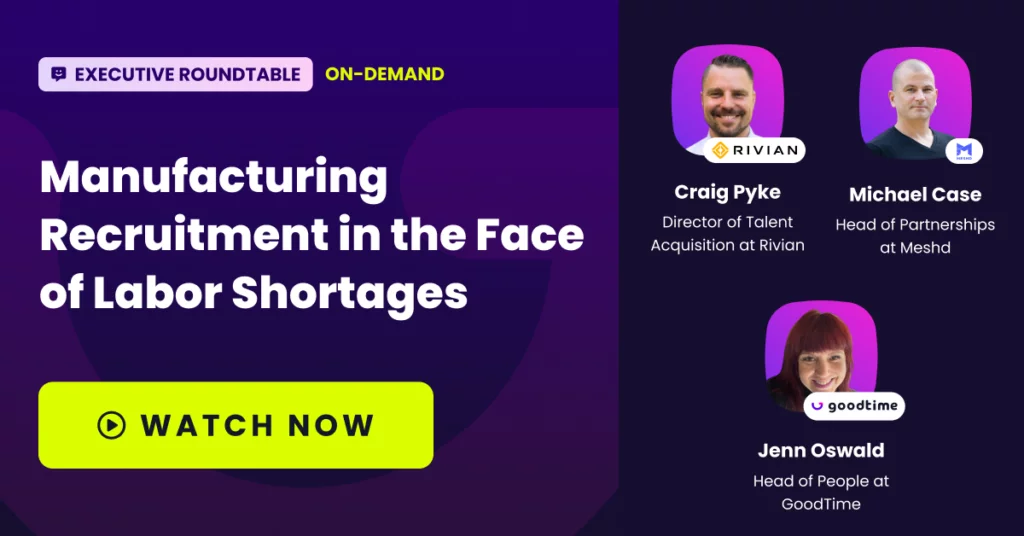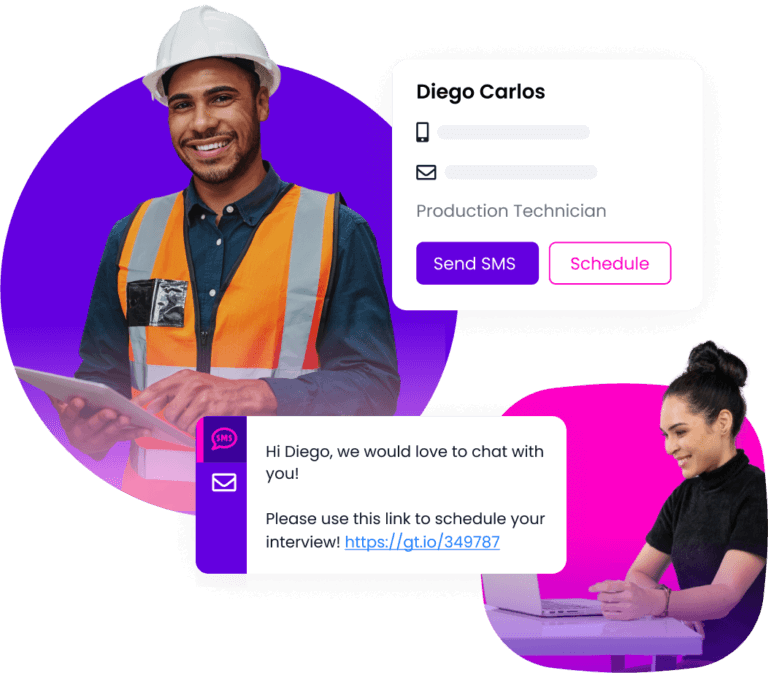Table of Contents
It’s no secret that the manufacturing industry has been through the wringer in recent years. Despite efforts to bounce back after the pandemic, the industry has faced an uphill battle in refilling vacancies. The numbers don’t lie: as of August 2023, a staggering 616,000 manufacturing jobs remained wide open, according to the US Bureau of Labor Statistics.
Our most recent Manufacturing Hiring Insights Report found that manufacturing companies, on average, are attaining only 44.3% of their hiring goals. If alarms aren’t going off in your head, they should be — these stats paint a concerning picture of the labor shortages and talent acquisition and retention struggles towering over the industry.
But still, not every manufacturing organization is struggling to stay afloat — some talent teams have learned how to navigate the turbulent waters. So, the question remains: what manufacturing recruitment strategies can still drive results?
We sat down with Craig Pyke, Director of Talent Acquisition at Rivian, and Michael Case, Head of Partnerships at Meshd, to shed light on manufacturing’s ongoing labor shortage and discuss adaptive recruitment strategies to power through these difficulties and start hitting your hiring goals again. We leveraged their combined 35+ years of recruitment experience to examine how software plays a pivotal role in addressing the ongoing manufacturing labor shortage.
Let’s dive in.

Unlock manufacturing’s top hiring strategies in 2024
Our study of 105 manufacturing TA leaders reveals how to hit your hiring goals in a challenging market.

Understanding the manufacturing labor shortage
You’re likely all too familiar with “The Great Reshuffle,” where the US labor market saw more than 50 million workers quit their jobs in 2022. Despite this mass exodus, hiring rates have consistently outpaced quit rates since November 2020, indicating that workers are transitioning to new opportunities rather than leaving the workforce altogether.

In addition to employees transitioning from manufacturing jobs to other careers, young people’s interest in learning trades or manufacturing skills has decreased.
“We’ve been focused on educating a whole generation that college is the answer,” says Michael. “That has come with a certain cost now that we’re trying to bring back manufacturing to the US.”
But that’s not the full story for manufacturing. After losing 1.4 million jobs at the onset of the pandemic, the sector has consistently struggled to attract and retain candidates for these job vacancies, with over 600,000 positions still unfilled.
There’s no straightforward solution. Even if every unemployed person with experience in durable goods manufacturing were employed, the industry would fill just 65% of the vacant jobs. As companies strive to attract skilled workers from the same shallow candidate pool, the talent competition shows no sign of cooling off.
And unfortunately, it’s not the kind of problem that time alone can solve. The National Association of Manufacturers anticipates that as many as 2.1 million manufacturing roles could go unfilled by 2031.

In this ultra-competitive environment, manufacturing recruitment needs to be faster and more proactive than ever. Recruiting leaders affirm that the teams that operate swiftly and communicate proactively are most likely to secure top candidates.
In response, manufacturing companies are evolving to adapt to the labor crunch. Let’s take a look at some game-changing strategies the experts have adopted to drive effective manufacturing recruiting in the face of labor shortages.
5 ways to improve manufacturing recruiting amid labor shortages
When you’re grappling with a shortage of skilled talent, traditional recruitment methods just won’t cut it. Here are a few strategies that can transform your manufacturing recruiting efforts:
1. Leverage technology to streamline recruitment
As competition for manufacturing talent continues to increase, speed and efficiency are critical in securing top candidates. This is where leveraging technology comes in. High-volume hiring platforms like GoodTime can help speed up the recruitment process by automating interview scheduling, allowing teams to connect with candidates instantly via text, and even scheduling interviews at scale.
The simple truth is that an ATS alone isn’t enough. You need to build from your ATS and supercharge it with additional tech built to solve the unique challenges of the manufacturing industry.
“If we start with the ATS as our most basic tool, there’s an entire tech stack on either side: outreach, sourcing, and interview scheduling platforms like GoodTime.” Says Michael. “There are so many tools. What do I really need, and what is nice to have? That’s what I think about when I design a system end-to-end.”

2. Prioritize candidate experience
Providing a positive and engaging candidate experience can set you apart from other companies. This includes clear and timely communication, a smooth application process, and showing respect for the candidate’s time.
Technology can also be a huge asset here — for example, you’ll want to be able to easily send 1:1 messages to candidates via email and SMS, and even bulk message groups of candidates for faster interview scheduling.
So, how do you make the process more fun and engaging for candidates? Craig says it’s all about who’s running the show: “What it comes down to is hiring the right person to do those different recruiting events. And sometimes, they may not have a traditional recruiting resume. People that are really fun and can work a room and bring people together to do different activities are the best fit, even if they don’t have a traditional recruiting profile.”
3. Optimize and streamline your interview process
To improve your time-to-hire, streamline your interview process as much as possible. That might also mean reducing the number of rounds a candidate completes.
Reducing time to hire doesn’t mean you need to eliminate important candidate assessments or rush through the process. It means streamlining or condensing the steps when it makes sense to do so.
“One of the ways to reduce that amount of assessment time is to have candidates do an activity where you can observe some of their behaviors and skills,” says Craig. “If you have them do an activity, oftentimes with other candidates, you can assess their ability to assemble a project, follow instructions, and work as a team. That way, you’ll be evaluating multiple skills at once rather than individually, which can save a ton of time.”
4. Make use of screening tools
To ensure that you’re focusing on the most qualified candidates, make use of basic screening questionnaires and knockout questions as part of your interview process.
For deeper screening, we recommend tools like SmartAssistant and Checkr that can quickly remove unqualified candidates and help you find the right match for each position more efficiently.
Additionally, as more manufacturing jobs are starting to involve robotic technology and utilize computer and coding skills, consider a tool like HackerRank that can assess candidates’ programming skills.
5. Integrate with existing tools and processes
To avoid disrupting your existing workflow, choose technology that integrates with your current processes and systems. GoodTime, for instance, allows you to text candidates directly from your ATS, send messages from any website right from your browser, and sync data back to your ATS or other databases. When considering a new tool, make sure it seamlessly integrates with your existing tech stack so that it actually helps you, rather than causing more headaches.
By adopting these strategies, you can turn the current labor shortage into an opportunity to boost your recruitment process and attract the talent your manufacturing company needs to thrive in 2024 and beyond.
How recruiting tools can revolutionize your manufacturing recruiting strategy
While there are a ton of strategies out there to improve your recruitment process, the biggest opportunity to make progress on your hiring goals is by leveraging the latest recruitment technology. Consider using recruiting and interview scheduling software that’s built specifically for high-volume roles. Look for a solution that provides a comprehensive solution designed to meet the unique needs of the manufacturing sector.
Let’s break down a few features of recruiting technology that can help you ramp up your manufacturing recruiting process:
High-volume recruiting
The key to overcoming labor shortages is making your recruiting process as efficient as possible. Use a platform that enables high-volume recruiting via text and email messaging, allowing you to connect with candidates instantly and schedule interviews faster. Getting in front of in-demand candidates before other companies can make a big difference.
Check out GoodTime’s high-volume recruiting software.
Automated interview scheduling
Automation is the future of recruitment. A great recruiting tool should help you schedule multiple candidates at once with the click of a button, view the current scheduling status of all candidates, and automatically send calendar invites, agendas, and reminders. This streamlines the process, cuts down on paperwork, and ensures a seamless candidate experience.
Hiring automation built for manufacturing
Re-ignite your interview process and schedule candidates up to 67% faster.

Configurable workflow automation
Recruitment tech lets you set up all sorts of automation, from simple to complex, based on various criteria. You can auto-send messages to job seekers and hiring folks, like invites, reminders, and friendly pokes, which makes your hiring process smoother and more personal.
Effective screening
Pre-built screening questionnaires and knockout questions help you quickly screen out unqualified candidates and focus on those who are right for the job. This leads to a more efficient hiring process and better matches between candidates and job roles.
Integration with existing processes
Ideally, any new recruiting technology in your tech stack should integrate seamlessly into your existing processes, allowing you to send messages to candidates from any website, send interview requests, view conversations, and get notifications.
Connection to your ATS
A great platform should bring candidate and job data from out-of-the-box integrations to your ATS when needed. This ensures a smooth flow of data and maintains the integrity of your recruitment process.
See all of this in action: GoodTime’s high-volume hiring features were built specifically with the manufacturing sector in mind. You can see them for yourself in our on-demand product tour.
Looking ahead: A brighter future for manufacturing recruitment in 2024 and beyond
As manufacturing recruiters roll with the punches of the post-pandemic world, it’s clear that the industry’s destiny hinges on how good they are at tackling today’s hurdles. As they continue to grapple with labor shortages, the focus of recruitment leaders in 2024 will be on improving time-to-hire in their interview process. This means a shift towards more efficient and streamlined recruitment strategies.
Innovative recruitment technologies are pivotal players in this transformation. By automating and optimizing the recruitment process, these platforms can help manufacturing companies effectively combat labor shortages and meet their hiring goals. The effective use of technology can provide a crucial competitive edge against companies that are stuck in the past.
The current labor shortage is a chance for manufacturing companies to revamp their recruitment strategies, innovate, and come out stronger on the other side. It’s time to seize this opportunity and revolutionize manufacturing recruitment for the future.
FAQs about recruiting in a manufacturing labor shortage
While traditional recruiting platforms are great tools, in an extremely competitive hiring landscape like manufacturing, talent acquisition teams need to think outside the box.
“I actually posted on a billboard recently,” says Craig. You have to get your company and your jobs in front of people, and sometimes just doing a simple thing like getting back to basics and physically getting in front of folks is one good way to go about it.”
Consider what platforms and mediums are going to most widely reach ideal candidates, and make sure your team has a presence there. That might also mean doing in-person presentations to high school students or other groups that are considering career options.
During the hiring process, it’s important to make candidates feel comfortable and valued. They won’t want to work for your organization if they aren’t excited about potential opportunities. For manufacturing companies, that might look like interactive tours, gamified skill assessments, panel discussions, team assessments, and more.
Both Craig and Michael predict that manufacturing hiring will increase in 2024 compared to 2023. “I think there’s a big push to bring manufacturing back to the United States,” says Michael. “There are US startups that we haven’t even heard of yet that are raising money to build and do more things. And then, you know, sitting here in East Asia, I can guarantee that in Taiwan, in Seoul, in Tokyo, everyone is talking about moving more of their stuff to the US, so I think we’re going to see a lot of that.”




